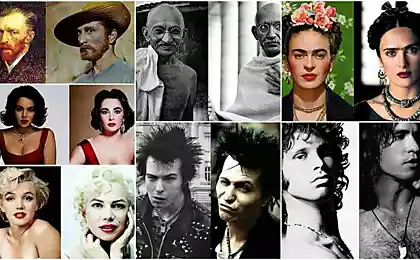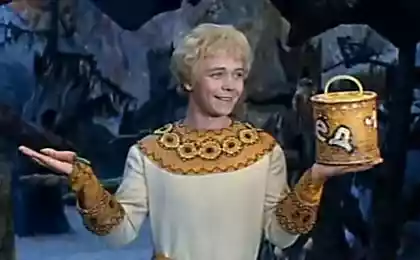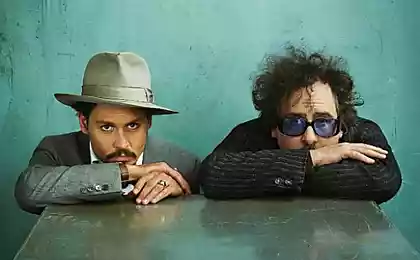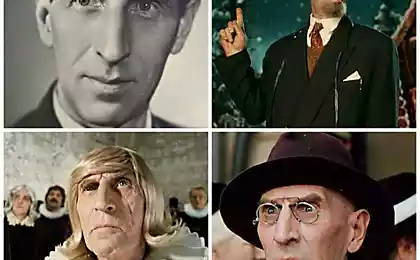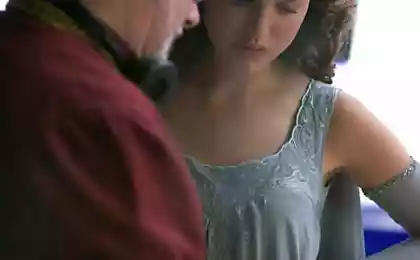2393
The special effects in the film «Mad Max: Fury Road». Part 1/2

Anyone who has watched the new "Mad Max", agree that the film came out juicy: the degree of madness going wild post-apocalyptic world, a complete lack of morals, a sense of hopelessness, powerful cars and colorful explosions. Action abounds and does not allow to look away from the screen for a second.
Contrary to modern trends to make a film exclusively in the pavilions with green walls, with the creation of Mad Max: Fury Road is still actively used and real explosions, more than 150 cars and stunt work. Of course, the film is present in considerable quantities and computer graphics combined with visual effects, but thanks to обширной article on fxguide we can know where reality ends and begins CGI. I>
The publication is divided into two parts for easy reading, because the source is huge. The original text of the contain major plot spoilers , so these parts of not available in translation , to those who have not watched the "Mad Max", but want to do it, have not lost the pleasure of viewing. i>
When the Джордж Miller decided to return to the world of Mad Max with his new band «Fury Road», he began a long journey that eventually ended six-month shooting in the deserts of Namibia. Directed by John Seale used in the course of several digital cameras to capture incredible stunts with more than 150 cars designed specifically for the filming of Mad Max designer Colin Gibson. create, manage and destroyed cars efforts of the team of experts, under the direction of special effects Andy Williams and Dan Oliver and stunt coordinator Guy Norris.
But intense shooting in Namibia, and after the Sydney - only half of the work done to create a post-apocalyptic landscape "Road rage". Hundreds of artists, led by their leader, Andrew Jackson, spent a lot of time giving a two thousand scenes of visual effects that will turn ordinary pictures into the final version of the movie, when watching that the viewer can feel like a participant in a mad car chase. Even more subtle manipulation of the footage spent colorist Eric Hipp, whose work gave the tape its own style and unique day and night lighting.

The original frame from filming in Namibia. I>
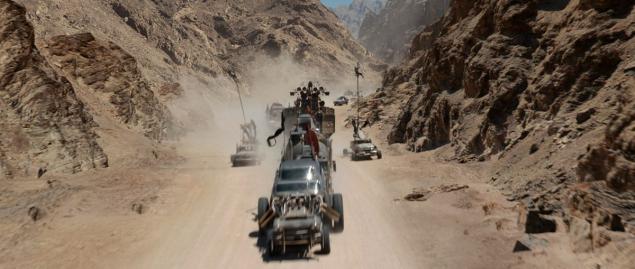
The final frame of film, studio Iloura . I>
During operation, Jackson helped the visual effects specialist Alex Bicknell and Fiona Crawford, who together with the studio Iloura took the lion's share of the work on digital processing. Together with Tom Wood was created more than 1,500 frames of varying degrees of complexity, such as the toxic storm or complex 2D-composition. Postvizualizatsiya pavilion was produced by the director's own tape Kennedy Miller prod (now Kennedy Miller Mitchell approx.) I >. Lapping personnel engaged Method Studios and BlackGinger conjunction with The Third Floor previs .
In this publication we will go through a number of key visual effects that helped to create imaginary scenes director. "I recently poshuchivali on the subject of the film touted as action with stunts and formally, the way it is," said Jackson. "In the film, a little computer graphics (CGI), but at the same time, we used the VFX in more than two thousand scenes. A significant portion of these effects are more like window washing: minor fixes, removing cables and tire tracks from previous surveys and the like, but there are enough scenes with a large number of visual effects. »
Create Citadel h4> 
The final image of the Citadel from the studio Iloura. I>
On a stone cliff in the desert, known as the Citadel on the film, the cult leader's own nonmortal Joe speaks to its "citizens" and announced the raid of gasoline led its voenachalnitsy Fyuriosy (it played Charlize Theron). While her "Battle Wagon" falls to the ground, Joe lets people get a bit of fresh water from the pipes of the Citadel.
The Citadel was built using a combination of shots made in Namibia and Sydney, as well as help create visual effects studio Iloura. Artists were photographed rock in Australia who after been treated with фотограмметрии. "I can not stand people who paint a rock" - shared Jackson, explaining why it was used photogrammetry. "I always try to use the real surface and shape as much as possible."

Model Citadel created using computer graphics. I>

The end result is. I>
Jackson was looking like the rock in Jordan, including an option for use as a prototype of the famous mountains of Wadi Rum, but eventually the desired location has been found in the west of the Blue Mountains near Sydney. "There's a rock two hundred feet in height, it's just amazing," says the director. "I took a helicopter and we flew to shoot rocks using high-resolution cameras. Footage of the Citadel have realistic lighting only because it was the correct moment to shoot when it was cloudy. Helicopter idle for ten days, until the desired us to weather. In the week and a half there was no cloud of the day, but we got excellent shots when the weather changed ».
On the use of photogrammetry in the process of creating the Citadel Jackson inspired by the drone Sensefly, which was used to photograph the area. "It was a small aircraft with a camera on board, measuring about a meter wide. You simply select the area you want to take a picture, throw it in the air and he takes off. The drone flight every two meters to take photos before returning to the place where he was running. Together with him Comes special software PhotoScan ».
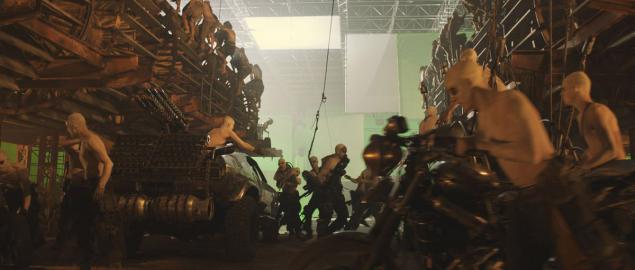
The original footage from inside the Citadel. I>

The end result is. I>
"It was four years ago, when no one had heard of PhotoScan», adds Jackson. "We started to use it to create a textured terrain models, and then experimenting with software that made them wish. Ilora done all the work on creation of the Citadel - they got the "raw material" in the form of images, we modify it and re-collected to the desired image ».
In fact, Iloura spent a considerable amount of time for the re-processing of the texture of the rocks that form the Citadel in its final form. "We had to build it piece by piece into a whole," says Wood. "George did not like the little dark inherent Blue Mountains, so we had to re-paint them and re-create textures to keep the realism of the image." This technology has also been applied to Dzhenolanskoy cave south of Sydney, which later became the corridors and rooms of the Citadel.

A computer model of the citadel. I>

The end result is. I>
In one scene, Joe turns to its citizens with a rock platform on the balcony, the place where the Citadel and open pipe with fresh water by means of levers ship pump. "Balcony was a huge number of iterations," says Wood. "There was a version filmed on one of the stages of filming at Fox Studios in Sydney, which was later completely replaced. The only thing that was real in this scene - it's four guys and pump lever. To create scenes were filmed about a hundred and fifty extras, which later turned into a thirty-thousand strong crowd. This place had no real prototype and we had to control lighting based on the image of the crowd. It was really difficult. "
Pouring water from pipes modeled using Houdini software package for panoramic scenes, virtually without using real water during filming. "They are modeled using special machines rain, aimed at a very small portion of the rock," describes the process of Wood. "Water mist and frames, where the water reaches the ground, were obtained with the actual shooting. All of the above - visual effects (VFX) ».
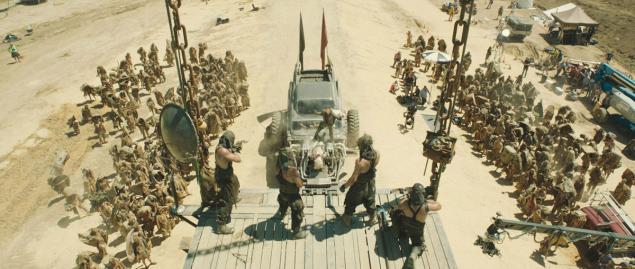
Scene from filming one of the scenes at the entrance to the Citadel. I>
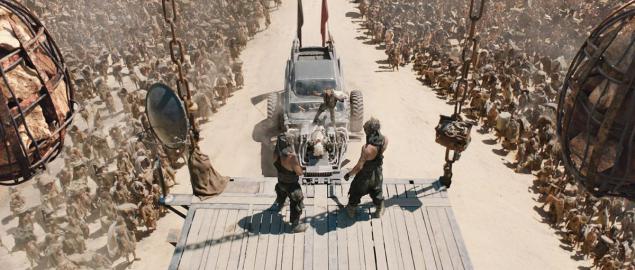
The final result after processing studio Ilora. I>
Inside the toxic storm h4> 
A scene from the movie. I>
The storm - a combination of the real frame, made in Namibia, and pictures created using computer graphics and modeling the behavior of liquids, dust and the use of computer models. Plus additional elements used VFX, to tie all together and ensure the presence of dust in the foreground.

A scene from the shooting in the desert. I>

The end result is. I>
Jackson notes that a similar result can be achieved only when using computer graphics, but in his view it was important to allow for the creation of such a scene used a real, moving cars. In his opinion, it is possible to preserve the realism of camera movements. "You're shooting" layout "with the car, which may gradually change," he says, "But the position of objects and the camera remain unchanged. Eventually, you have to mind can and does nothing left of the layout, but the final scene will inherit part of what was originally captured. I believe that this is to take it because of this inheritance ».
The filmmakers figured where there will be tornadoes in the final version, and these data were placed on the path of the car. From this, and accordingly we are moving automobiles. "Then, during the filming in the desert, we did a lot of work needed to create postvizualnyh effects. This definition of the size, position in space, scope and direction of the entire scene, "Jackson says. "Then it was clear that tornadoes are modeled from fluid motion. Tom Wood has worked on a variety of concepts, studying tornadoes and propose options a tornado of fire in dust clouds. The idea was just fantastic. »

The computer model. I>

The end result is. I>
Wood, along with artists, developed several concepts scenes where shown a storm and tornadoes that after Miller argued. "What we did first was, in fact, been rejected and cut," he says Wood, "and then we started working on combining the dust storm and lighting. It was difficult, because all materials were shot in bright sunlight on a completely flat desert terrain. Machinery raises dust and glare given that we needed to fix. »
At the crash scene in a storm used cars by Iloura using computer graphics. For this purpose, using photogrammetry models were created that were processed after PhotoScan. "You get an excellent model," says Wood. "But the quality is highly dependent on the presence of glare and reflections on the pictures. If they are, then the final image you get bumps and dents. "

Animation option separation machine from the ground. I>

The end result is. I>
Most obviously the use of computer graphics can be seen in the scene when the tornado lifts a car and a group of fighters in the air, after the collision with the "Battle wagon." Car breaks into pieces and parts of rush towards other cars past the camera. "In preparing the special effects Miller asked us to use the equipment, which records the actual direction of air flow. This was done to ensure that in the future, by adjusting the scene, follow the real physics and dynamics of the air. " By way of background information producer has used recording accidents from various sources, which show the whole process in motion. Wood is also used for recording accidents motorcycle racing. "If you lose support at high speed, you also lose and control your hands and feet - they move mainly in the likeness of a windmill.»
Studio Iloura apply the data about the behavior of objects in the real world when creating digital doubles fighters using software Endorphin. When Miller saw the result of their work, he realized that such an approach does not suit. "The reason is," says Wood, "that there is a real difference between what happens in real life and what is happening in the movie. We are all accustomed to the fact that doing stunt during the filming of accidents and other such scenes they will jump to bounce on the ground, rotate your hands in the air and move your legs as if riding a bicycle - is an exaggerated representation of the behavior of people, cinematic clichés. " Ultimately Iloura returned to a more complex, "cine" model of human behavior in free flight.

The original picture from the shooting. I>
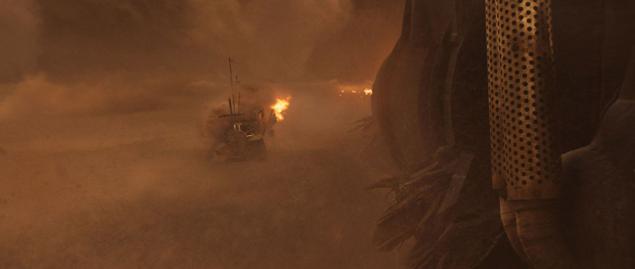
The end result is. I>
Meanwhile, Iloura again used Houdini to create tornadoes and dust clouds. "They had a lot of practical information about tornadoes," explains Wood. "All the devils had a random shape - George wanted to be sure that they do not look the same, have a unique look. We have created about seven layers of dust on the ground level, the similarity of how the arctic regions of wind lifts the snow crumbs, until the middle of the car. Above this level were set up huge billowing dust vortices, which appeared and disappeared a car on the other side. I think such a series of frames in the style of "hide-show" (trudnoperevodimaya phrase "conceal and reveal" approx.) I>, is perfect for the chase, when you only catch a glimpse of cars ».
Research and engineering team Iloura (Research and Development team note.) I> is written specifically Tools, which he called "Slice and dice". "Basis" of a tornado was our volume shader, "wrapped" in a huge number of particles created using Houdini. After the whole thing passed through the "meat grinder" to provide completely random form dust clouds. Because of this, the filmmakers were able to create an unpredictable svetopredstavlenie inside storm.

The original frame. I>

The end result is. I>
To give the final form of the toxic storm, Jackson decided to add a twist to the frame of dust hits the camera at the moments when the action takes place near the car. "I ran a huge amount of dust in the side of the camera," he says. "We went into the studio Old Doctor D in Sydney. There I got enough space to provide a black background - we were shooting very bright illumination in the foreground. Dust was lit so brightly that I could without any problem to put fans in the background - they simply could not see. "
Source: geektimes.ru/post/251318/
RAS will release historical encyclopedia Wikipedia as a reliable alternative
Dual USB Flash Drive: USB flash drive from SanDisk future






























